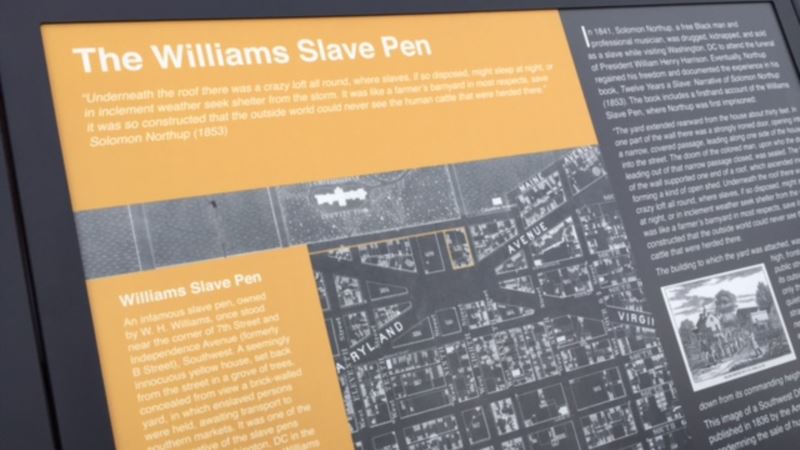Most visitors easily recognize Washington, D.C., landmarks such as the U.S. Capitol or the White House. However, many might not know these and other iconic structures in the nation's capital were built by black slaves during one of the darkest chapters in American history. More than a century-and-a-half after slavery was abolished in the United States, the hardships and sacrifices blacks endured are being recognized. Outside a sprawling U.S. government office building not far from the Capitol, two historical markers were unveiled, pointing silently to the site of a notorious slave prison where hundreds of black men, women and children were confined, waiting to be sent to white slave owners. "It was one of the most horrible examples of what humans can do to each other," said Anthony Foxx, who heads the U.S. Department of Transportation. Foxx, whose ancestors were slaves, joined several other federal government leaders dedicating the signs marking the site where the Yellow House Slave Pen once stood. "These historical signs clearly outline the past and make people realize how much progress the country has made in more than 150 years," said Foxx, adding that they also serve as "a reminder that we as Americans are all involved in making things better." Washington slave trade The slave prison, a yellow house with tall walls, was owned by W.H. Williams. After slaves were sold, they typically worked in some form of domestic service, although others helped construct buildings as the city grew in the first half of the 19th century. The history of the slave jails was brought to light by Solomon Northup, who wrote about his imprisonment there in 12 Years a Slave — a book that became a highly acclaimed movie in 2013. Northup, a free-born African-American from New York, traveled to Washington as a musician but was kidnapped by white men and put in the slave pen. His writings described the jail as being "within the very shadow of the U.S. Capitol." After being sold into slavery in 1841, Northup spent 12 years trying to regain his freedom. Slavery existed in Washington until April 16, 1862, when President Abraham Lincoln signed legislation freeing thousands of African-Americans bound by the capital city's slave code. Educational tool The people who worked to establish the historical markers at the slave pen site say the signs will educate people, especially younger generations, about the lucrative domestic slave trade in the District of Columbia. "If we are going to work together to build a brighter future, we have to acknowledge and remember the mistakes of the past," said Michael Huerta, who heads the Federal Aviation Administration and helped to unveil the plaques. "There's the old saying that those who don't understand history are doomed to repeat it," Huerta told VOA. "It is important that we understand what happened here and move beyond that to make this a greater country" in the future.
US Government Recognizes Site of Former Slave Prison






